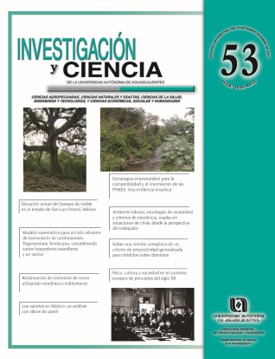Current status of cloud forest in the state of San Luis Potosí, Mexico
DOI:
https://doi.org/10.33064/iycuaa2011534487Keywords:
cloud forest, deforestation, fragmentatio, Sierra Madre Oriental, LiquidambarAbstract
This paper analyzes the distribution and dynamics space-time of cloud forest in the State of San Luis Potosí. Mexico. This forest is characterized by the restricted geographical distribution throughout the country, as well as being severely threatened by human activities. This ecosystem is located in the Sierra Madre physiographic region, between l,000 and l,600 m of altitude, on a geological substratum of shale and limestone-sha le. lt has an extension of 3,239 hectares distributed in eight relicts.This forestshows a high levelof deforestation and fragmentation because in the post 35 years it has lost over 2,868 hectares of forest. In sorne of these relict oreas, deforestation rotes were higher than 33 per year. Even though, sorne of these relicts are located within oreas of high priority for conservation, none is officially protected.
Downloads
References
CHUVIECO. E.• Fundamentos de Teledefección espacial. Madrid: Ed. Riopl. 1990.
CHALLENGER. A.. Utilización y conservación de los ecosistemas terrestres de México, posado, presente y futuro. México: CONABIO-IB-UNAM-Agrupoción Sierro Madre, 1998.
FORTANELLI M.J.:CASTILLO, L.P.; FLORES. C.J.A.; GARC A. P.J.;MARTINEZ.V.G.;REYEs,H.H.:SANDOVAL M.C., Estudio geográfico, ecológico y etnobotánico de un relicto de bosque de niebla de Son Luis Potosí, México. Memorias del X Congreso Latinoamericano de Botánico. Chile: Universidad de Lo Sereno,2010.
GUEVARA,S.;LABORDE. J.. Historio del paisaje de lo sierro de Los Tuxtla, Veracruz (México). En: Díoz Pineda, F.;De Miguel. J.M.;Casado, M.A. {coords.), Diversidad biológico y cultural rural en o gestión ambiental del desarrollo. España: Cooperación españolo y Multimedia ambiental, 1999.
INEGI. Corto de vegetación y uso del suelo. CD Valles F14-8,Escalo 1:250,000, 1985.
INEGI.Carta de vegetación y usa del suelo Serie 11.CD Valles F14-8,Escalo l:250,000. 2002.
KAPOS. V.; WANDELLI. E.:CAMARGO, J.L.: GRANADE. G ., Edge-reloted chonges in environment ond plont responses due to forest frogmentotion in CentralAma zonio.In: Louronce, W.F.; Bierregoord Jr., R.O. {eds.), Tropical Forest Remnonfs. Ecology. Monogement ond conservotion of frogmented communities . USA: The University of Chicogo Press,1997.
LILLESAND. T.M.;KEIFFER. R.W.;CHIPMAN,J.W.. Remole sensing ond imoge interpretotion. New York: John Wi ley & Sonslnc .. 2004.
MASS, J.F.. Chonge estimotes by mop comporison: o method to reduce erroneous chonges due to posifio nol error; Tronsoctions in GIS. Vol. 9,No. 4, pp. 619-629, 2005. DOI: https://doi.org/10.1111/j.1467-9671.2005.00238.x
MASS, M.J., Conversion of tropical dry forest to pos ture ond ogriculture. In: Bullok, S.;Money. H.;Medina, E.. (eds.), Seosonolly dry tropical forests. Cambridge: Cambridge University Press, 1995. DOI: https://doi.org/10.1017/CBO9780511753398.017
MONTOYA,T.J.N.,Diagnóstico part cipativo de los pro cesos de deforestación endos comunidades delo Sierra Madre Oriental del estado de Son Luis Potosí. Tesis de Maestría PMPCA-UASLP. 2009.
PUIG, H.• Lo biogeogrolío de los plantos del bosque mesófilo. En: Sónchez Romos,G.;Reyes Castillo. P.:Dir zo. R. (eds.). Historio Natural de o Reservo de lo Biosfero el Cielo. México: UAT.2005.
PUIG,H.• Vegetación de o Huosfeco, México. Estudio fifogeográfico y ecológico. México:lnstitut Froncois de recherche. Scientifique tour le Developement en Co opérotion (ORSTOM)-lnstituto de Ecología A.C.-centre D'Ettudes Mexicoines et Centroméricoines {CEMCA). 1991.
REYES, H.H.; AGUILAR ROBLEDO, M.; AGUIRRE. R.J.R.: TREJO,V.1.. Cambios en lo cubierto vegetal y uso del suelo en el óreo del proyecto Pujo l-Coy, Son Luis Po tosí,México. Investigaciones Geográficos. Vol. 59,pp. 26-42,2006.
RZEDOWSKI. J.. Vegetación delestado de Son Luis Po tosí.Tesis Doctoral. UNAM, 1966.
RZEDOWSKI. J.. Vegetación de México. México: Edito riallimusa, 1986.
RZEDOWSKI. J.. Anólisis preliminar delo floro vascular de los bosques mesófi os de montaña de México.Acto Botánico Mexicano. Vol. 35, pp. 25-44, 1996. DOI: https://doi.org/10.21829/abm35.1996.955
SADER.S.A.; REINING, C.; SEVER.T.; SOZA, C.. Human migrotion ond agricultura! exponsion, o threot to the Moyo tropicalforest. Joumolof Forestry. Vol.95,No. 12. pp.27-32. 1997. DOI: https://doi.org/10.1093/jof/95.12.27
SEMARNAT-UNAM. Inventario Forestal Nocional 2000. México: Instituto de Geografía, UNAM-Secretorío de Medio Ambiente y Recursos Naturales. 2002. Escalo 1:250,000.
SEMARNAT, Compendio de Estadísticos Ambientales. México. 2007.
TREJO,l.;Dirzo.R .. Deforestotion of seosonolly dry tro pical forest: o not onol ond local onolysis in Mexico. Biologicol Conservotion. Vol. 94, pp.133-142,2000. DOI: https://doi.org/10.1016/S0006-3207(99)00188-3
WILLIAMS LINERA. G.. El bosque de niebla del centro de Verocruz: Ecología, historio y destino en tiempos de fragmentación y cambio climático. México: CONA BIO-lnstituto de Ecología,2007.
Downloads
Published
How to Cite
License
Copyright (c) 2011 Edgar G. Leija Loredo, Humberto Reyes Hernández, Javier Fotanelli Martínez, Gerardo Palacio Aponte

This work is licensed under a Creative Commons Attribution-NonCommercial-ShareAlike 4.0 International License.
Las obras publicadas en versión electrónica de la revista están bajo la licencia Creative Commons Atribución-NoComercial-CompartirIgual 4.0 Internacional (CC BY-NC-SA 4.0)









